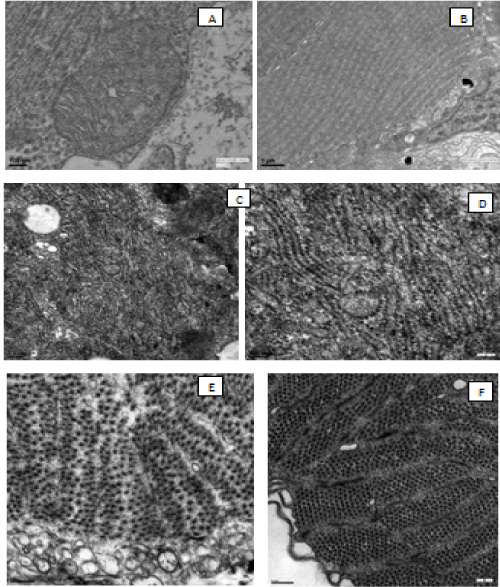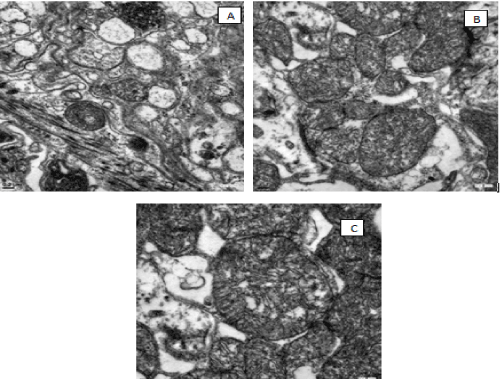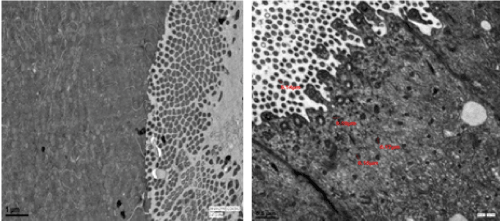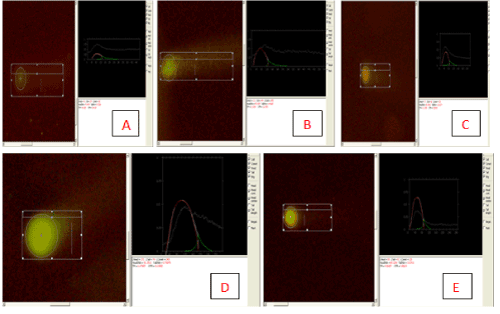Research Article Open Access
Bioaccumulation of ZnO-NPs in Earthworm Eisenia fetida (Savigny)
| Shruti Gupta and Shweta Yadav* | |
| Department of Zoology, School of Biological Sciences, Dr HS Gour Central University, India | |
| Corresponding Author : | Shweta Yadav Department of Zoology, School of Biological Sciences Dr HS Gour Central University, India Tel: 9479983812 E-mail: kmshweta3@yahoo.com |
| Received July 11, 2014; Accepted September 20, 2014; Published September 22, 2014 | |
| Citation: Gupta S, Yadav S (2014) Bioaccumulation of ZnO-NPs in Earthworm Eisenia fetida (Savigny). J Bioremed Biodeg 5:250. doi:10.4172/2155-6199.1000250 | |
| Copyright: © 2014 Gupta S, et al . This is an open-a ccess article distributed under the terms of the Creative Commons Attribution License, which permits unrestricted use, distribution, and reproduction in any medium, provided the original author and source are credited. | |
Related article at Pubmed Pubmed  Scholar Google Scholar Google |
|
Visit for more related articles at Journal of Bioremediation & Biodegradation
Abstract
Zinc oxide nanoparticles (ZnO-NPs) are increasingly used in nano fertilizers, sunscreens, biosensors, food additives, pigments, rubber manufacture and electronic materials. With wide application of ZnO-NPs, concern has been raised about its unintentional health hazards and environmental impacts. In the present study, we tested toxicity and uptake of ZnO-NPs as a marker of potential ecological harm. We provided multiple lines of evidence including, percentage of mortality, DNA damage, superoxide dismutase, lignin peroxidase, cellulolytic activity and transmission electron microscopy of coelomic fluid and earthworm tissue to express bioavailability and bioaccumulation of ZnONPs from soil to earthworm. The aggregates of NPs were observed in coelomic fluid and their tissues, away from portal of their entry. The results from response of antioxidant system combined with DNA damage indicated that ZnO-NPs could not induce significant damage to earthworms. The study demonstrated bioavailability of ZnO-NPs was very high throughout the earthworm cross sections in all exposures of NPs particularly at exposure of 10nm sized ZnO-NPs and revealed that intact NPs can be taken up by earthworm from soil and having good potential of bioremediation into non- toxic forms.
| Keywords |
| Bioaccumulation; DNA damage; ZnO-NPs; Biodistribution |
| Introduction |
| Zinc oxide nanoparticles (ZnO-NPs) is among the most commonly utilized group of nanomaterials and has a wide ranging application [1]. As a well-known phytocatalyst, ZnO has received much attention in the degradation and complete mineralization of environmental pollutants [2-4]. ZnO-NPs are used in industrial products including cosmetics (sun screens, foot care, ointments and over-the-counter tropical products), pigments and coatings (ultra violet [UV]) protection, fungicide in paints), mouth washes, electronic devices and catalysts [5]. ZnO-NPs have also been used as a dietary supplement in human and live stock because Zn can stimulate the immune system and act in an anti- inflammatory way [6,7]. Many in vitro studies have demonstrated that ZnO-NPs are toxic to mammalian cells and even more toxic than other nanoscale structures of metallic oxide [8-10]. Some studies have reported that ZnO and its NPs have strong absorption abilities for a series of organic compounds and heavy metals [8,11]. In combination with UV exposure, ZnO-NPs are known to generate reactive oxygen species (ROS) like hydroxyl radicals or hydrogen peroxide in aqueous solutions leading to efficient decomposition of organic compounds [12]. Brunner et al. [13] showed that a three-day exposure of human mesothelioma and rodent fibroblast cell to ZnO-NPs (19 nm) caused DNA and mitochondrial changes. In addition to increasing our understanding of NPs toxicity, it is necessary to adequately study the properties of ZnO-NPs and, therefore, there is an urgent need to understand their toxicity in organisms and the environment through the processes of absorption, biodistribution, metabolism, and excretion of nanomaterials in vivo with a view to ensure that their applications are safe and provide helpful information to develop nanomaterial safety standard. |
| Earlier a series of physiological effects induced by ZnO-NPs have been observed in rainbow trout, Oncorhynchus mykiss [14], micro algae Pseudokir- chneriella subcapitata [15], crustacean Daphnia magna and Thermo- cephalus platyurus and bacteria Vibrio fischeri [16]. However, research on the toxicity of NPs are far from being complete, and the studies of potential adverse effects and related mechanisms exerted by NPs in the soil ecosystem are still limited [16-19]. |
| During the life cycle of these commercial products, NPs may be released from products through normal use and then wastewater streams into the environment and become a threat to ecosystems. A significant portion of NPs in waste water are expected to release into sewage sludge [20,21]. Depending on local practices, varying proportions of sewage sludge are disposed of in landfills, incinerated, or applied to agricultural lands as biosolids. Usually 60-80% of sewage sludge is applied to the land [22]. Therefore, terrestrial eco-systems are expected to be an ultimate sink for a large portion of NPs [23]. This raises concerns about their potential for ecological effects, entry into food webs, and ultimately human exposure from consumption of contaminated agricultural products [24]. Therefore, it is of great interest to determine if intact NPs can be taken up by organisms from soil. This data can then be used in the nano risk framework above to assess the overall risk posed by ZnO-NPs. Currently; there are limited toxicity data for nano-sized metal oxides especially in a terrestrial system. Our study addresses this data gap using earthworms and to investigate the uptake of NPs and their biotransformation in soil ecosystems using ZnO-NPs as a probe. |
| In this study earthworm (EW) Eisenia fetida (Savigny,1826) was acutely exposed (because it occupies 60-80% of the total soil biomass and common in wide range of soil) to artificial soil systems containing different concentrations (0.5, 1.0, 1.5, 2.0, 2.5, 3.0, 3.5, 4.0, 4.5, 5.0, 5.5, 6.0, 6.5, 7.0, 7.5, 8.0, 8.5, 9.0, 10.0 mg/kg) and different sizes (100 nm, 50 nm, 35 nm, and 10 nm diameter) of ZnO-NPs. The toxicity end points in vivo biochemical and genotoxic responses to stress caused by these NPs were evaluated to understand and to provide more information on their uptake and potential to use these as biotransformation agent. |
| Materials and Methods |
| Characterization of ZnO nanoparticles |
| ZnO-NPs (100 nm, 50 nm, 35 nm, and 10 nm diameter) were purchased from Sigma-Aldrich. The morphology and size of NPs was examined using transmission electron microscopy (TEM) at Sophisticated Instrumentation Facility Centre, All India Medical Institute, New Delhi, and The Energy Research Institute, New Delhi, India. |
| Bioassay |
| The design of the EW reproduction, bioaccumulation, biochemical test and sub chronic lethality assays followed published OECD guidelines [22] and Unrine et al. [23]. Twenty clitellate adult E. fetida weighing 0.30 ± 0.12 g each in three replicate exposure chambers containing 1 kg dry mass of artificial soil medium were chosen for test experiment. The soil medium consisted of 70% quartz sand, 10% peat moss and 20% kaolin. The pH was adjusted with the addition of a small amount of crushed limestone. Different doses of 100, 50, 35, 10 nm (0.5, 1.0, 1.5, 2.0, 2.5, 3.0, 3.5, 4.0, 4.5, 5.0, 5.5, 6.0, 6.5, 7.0, 7.5, 8.0, 8.5, 9.0, 10.0 mg/ kg) were added to dry soil and mixed by homogenizer for 5 minutes and moisture content was maintained for 60%. Particular moisture content was maintained for perfect solvability of feed materials for earthworms as observed in our earlier investigation [25,26]. Soil sub-samples were also taken at the beginning of the exposure from each exposure chamber. After 28 days of exposure, total number of earthworms were counted, following ten earthworm from each exposure chamber frozen at -80°C, while the remaining earthworms were allowed to avoid their coelomic fluid in saline for 24 hrs and stored frozen to evaluate total Zn content, aggregates of NPs in their tissues and other biochemical analysis. |
| For estimation of Zn concentration in body tissue, three EW of each group were weighed and digested with 3 ml of conc. nitric acid for 24 hrs. After digestion, the acid was evaporated and the residue dissolved in 4% nitric acid. Zinc concentration was quantified with ICP-AES at The Energy Research Institute, New Delhi, India |
| The superoxide dismutase (SOD), lignin peroxidase, cellulase was determined following Hu et al. [27]. Prior to biochemical analysis each earthworm (3 for each group) was cut into pieces and mixed with icecold 0.86% NaCl. The mixture was homogenized and centrifuged at 4000 rev min-1 at 4°C for 10 min. The resultant supernatant was used for estimation of enzymatic activities. |
| For the analysis of aggregates of zinc nanoparticles, coelomic fluid was obtained according to the non- invasive extrusion method described by Hu et al. [27]. Individual EWs were rinsed in the extrusion medium which consisted of 5% ethanol, 95% physiological saline, 2.5 mg/ml EDTA and 10 mg/ml glucol glyceryol ether (pH 7.3). Coelomocytes were washed with phosphate buffered saline (PBS) for examination in transmission electron microscopy (after fixation) and for comet assay. The comet assay was performed as described by Singh et al. [28]. Ethidium bromide stained nuclei were examined with fluorescent microscope (Leica Microsystems). Images were analyzed with the software CASP according to the method of Collins et al. [29]. The EW specimens were fixed in 2.5% glutaraldehyde and made into embedded sections following routine techniques for Transmission Electron Microscopy (TEM) characterization to examine the gut epithelial cells of EW. |
| Statistical analysis |
| Results are the means of three replicates. Two way analysis of variance (ANOVA) was performed by using the SPSS 10.5 software. The objective of statistical analysis was to determine any significant differences among the parameters analyzed in different treatments during the determination of uptake of ZnO-NPs and its potential use as tool for toxicity biomarker. |
| Results and Discussion |
| Survivability of earthworms exposed with ZnO-NPs |
| The survivability of EWs was tested after exposure of ZnO-NPs (100 nm, 50 nm, 35 nm, and 10 nm) in wide range of concentrations (0.5 to 10 mg /kg.).In the mortality range finding experiment (Table 1), it was found that E. fetida survived even at a high concentration (10 mg/kg). Commercially < 5.0 mg/kg NPs are used as nano fertilizer for release of Zn in soil ecosystem. Thus, the highest concentration was considered to be 10 mg/kg, which represents a worst case scenario. |
| EWs did not show significant mortality at exposure of 100, 50 and 35 nm, after 28 days . However, there was little increase in percentage of mortality at exposure of 10 nm NPs at >5 mg/kg. Study suggests that there is no significant mortality with decrease in size of NPs at the exposure <5 mg/kg. At higher concentration >4 mg/kg the particle size in coelomic fluid was observed larger than its original size, which indicates aggregation of the nanomaterial in the EWs’coelomic cavity. This aggregation may explain the survival of EWs at higher concentration. However, aggregation does not explain increase in mortality observed for 10 nm sized NPs. Zinc ion toxicity may be another reason since nano-sized ZnO was sonicated before in Mill-Q water and may become a free ion in the artificial medium. We observed no statistically significant effects of any of the treatments on EWs’ body mass. There was sporadic mortality in some treatments that was neither concentration dependent nor statistically significant. |
| Zn Accumulation in earthworms |
| After 28 days exposure, the Zn content in body tissue was measured and result exhibits increase in bioaccumulation levels from the portal of entry (Figure 1) along with increase in NP dose and decrease in size of NPs (Table 2). Highest Zn accumulation (36.18 ± 3.17 μg/g) was observed at exposure of 10 nm @8 mg/kg. However, 18.45 ± 0.94 μg/g for 100 nm at 7.5 mg/kg; 18.80 ± 1.10 μg/g for 50 nm at 9 mg/kg; 24.67 ± 3.20 μg/g for 35 nm at 7.0 mg/kg. The accumulation of Zn ranges 4.13 ± 0.20 to 18.45 ± 0.94 μg/g at exposure of 100 nm; 4.12 ± 0.78 to 18.80 ± 1.10 μg/g for 50 nm and 4.56 ± 0.60 to 24.67 ± 3.20 μg/g for 35 nm and 5.58 ± 0.70 to 36.18 ± 3.17 μg/g for 10 nm. Highest uptake of Zn was recorded at the exposure of 10 nm sized particle which indicates accumulation of Zn content is size dependent of NPs. The results suggest that the EWs can uptake and accumulate 20 - 36 μg/g content in their body tissue, even by increasing the dose and decreasing the size of NPs. However, bioavailability of NPs increases with decrease in size of NPs. It has been shown by Gardea-Torresdey et al. [30] that Au1± and Au3± can also be taken up from soil by plants and subsequently reduced to metal within the tissues. To our knowledge, this is the first evidences that this process also occurs for reduction of ZnO into Zn metal by EWs. |
| Increase in Cellulolytic activity |
| The cellulolytic activity of EWs’ gut increased with the decrease in size of NPs (Table 3). Although, no statistically significant differences appeared in the activity of cellulase as compared to control for 100 and 50 nm sized ZnO-NPs upto exposure 0f < 7.5 mg/kg. In contrast at exposing of 35 and 10 nm it increases 38-41%. Significant increase were recorded at the exposure of 10 nm @ >3.0 mg/kg. Results suggesting increase in cellulolytic activity in earthworm gut after the exposure of ZnO-NPs may be helpful in and agree with the bioconversion process of lignocellulolytic wastes [26]. |
| Cellulose is the most abundant polymer in nature and constitutes a large pool of carbon for microorganisms, the main agent responsible for soil organic matter decomposition. EW influences decomposition of cellulose indirectly by affecting microbial population structure and dynamics and also directly because the guts of some species posses cellulolytic activity. In nature, cellulolysis occurs as a result of the combined action of fungi and bacteria with different substrate requirements that shift their biomass depending on what substrate is being metabolized [31]. Degradation of cellulose is a slow process that is limited by several factors involving cellulases, such as concentration, location, and mobility of the enzymes [32]. Decomposition of lignocellulosic residues is directly mediated by extracellular enzymes [33]; therefore, analysis of the dynamics involved in increase of cellulolytic activity with exposure of ZnO-NPs may clarify the mechanisms relating the rate of decomposition with substrate quality and nutrient availability as reported by Sinsabaugh and Linkins [34]. In recent years, there is increasing interest in how soil fauna shapes the composition of soil ecosystem; thereby affecting decomposition, nutrient cycling and bioremediation. EWs represent an important portion of soil invertebrate biomass and, in many ecosystems, they are undoubtedly the key organisms in organic matter decomposition by modifying soil nutrient and microbial dynamics. Earlier reports of cellulolytic activity in the gut of some species of earthworms especially in epigeic earthworm E. fetida indicate their ability to digest cellulose, although the effects exerted by earthworms on cellulolysis lie fundamentally in their interactions with soil ecosystem [35]. However, these interactions are the subject of a certain amount of controversy and experimental conditions assayed. Hu et al. [27] reported the activity of cellulase in E. fetida was decreased as the concentrations of the NPs increased, indicating the earthworm experienced stress from the NPs. Although activity of cellulase appeared to drop in all treated groups (0.1 to 5 g/kg) of TiO2, yet there are no statistically significant differences observed compared to control even at high dose. In contrast, when EWs were exposed to 1 to 5 g/kg soil of ZnO, the activity of cellulase showed a significant decrease. It was, therefore, concluded ZnO was physiologically more effective to E. fetida thanTiO2. |
| Activity of lignin peroxidase and Superoxide dismutase |
| Song et al. [36] suggested biochemical responses of organisms to environmental stress are as early warming indices of pollution in the environment. Many enzymatic activities have been considered as biomarkers of environmental pollution [37]. Many of these enzymes include anti-oxidant activities and they protect cells against adverse effects of Reactive Oxygen Species (ROS). Normally, cells are able to reduce oxygen to water through their electron transport chains and protect themselves from normal ROS damage through the use of enzymes such as SOD. Therefore, the SOD activity was measured to study the toxicity of ZnO-NPs. This could work to convert O2 and H2O2 into harmless H2O and O2, reduce the formation of hydroxyl free radical -OH, a toxic and active oxidant, as well as lower the overall free radical content of cells. Results indicated that no significant oxidative stress induced in EWs by ZnO-NPs (Table 4). The active oxygen atoms generated by peroxide resulted in instability of the plasma membrane. In present investigation, no significant variation tendency was observed in lignin peroxidase and SOD after the exposure of NPs to worms. There was sporadic increase in some of the treatments that was neither concentration dependent nor size dependent. Therefore, we concluded that activity of lignin peroxidase and SOD was not likely the result of exposure of NPs. The concentration of lignin peroxidase varies from 5.28 ± 0.08 to 8.39 ± 0.69 Umg/prot which doesn't show any significant correlation with size and dose of NPs. However, there was little increase with exposure of 35 and 10 nm which was not showing response with increase in dose. SOD activity varies from 0.13 ± 0.68 to 0.16 ± 0.02 Umg/prot. However, a little decreasing tendency in SOD was also shown with decrease in size of NP and increase in dose of exposure (Table 4) and, was statistically non-significant. |
| TEM Analysis of Coelomic fluid and tissues |
| After the exposure of NPs the coelomic fluid and gut tissue was examined under Transmission Electron Microscope. There was a large agglomeration of NPs observed in coelomic fluid and EW’ tissues (Figure 2). The study demonstrated bioavailability of ZnO-NPs was very high throughout the earthworm cross sections in all exposures of NPs (Figure 2) particularly at exposure of 10 nm sized ZnO-NPs. The aggregate (100-200 nm) of NPs was also recorded within the cytoplasm. However, there was no clear primary particles size dependence for accumulation on a mass concentration basis, although on a particle number basis, many more micro-size particles were observed. The accumulated concentrations were nearly identical between particle sizes at the lowest concentration but were higher for 10 nm at intermediate to higher exposure (Figure 3). This may be related to observation of Unrine et al. [23] that the aggregation of Au nanoparticles (20 nm) at higher concentration which were more extensively aggregated in the soil pure water than the 55 nm particles and had a larger average hydrodynamic diameter. Chithrani et al. [38] have shown uptake of 50 nm NP by endocytosis in HeLa cells. In contrast, a study in mice exposed via drinking water showed that 4 nm Au NPs were greater absorbed to much greater extent than 10-58 nm Au NPs and there was a trend of decreased uptake with increasing size over the range of 10-58 nm [39]. These studies did not investigate the aggregate size of Au NPs in the exposure media. Such characterization is particularly difficult in complex media such as soil pure waters that contain naturally occurring colloids. Continued development of improved methods to quantify aggregation state in soils and sediments at trace concentrations are needed to help identify the processes that influence NP bioavailability in soil [23]. Large amount of mitochondria was observed in cells of inner surface of the gut. No abnormal appearance in mitochondria was observed with exposure of any NPs (Figures 2 and 3) in present investigation. |
| No DNA Damage to earthworm |
| Tail DNA and olive tail moment (OTM) was studied by using Comet Assay test. Results are shown in Figure 4. No significant DNA damage was observed with exposure of NPs in our earlier publications [40,41]. Peralta-Videa et al. [2] have also reported that exposure of TiO2, ZnO-NPs did not cause DNA damage in earthworms. Sharma et al. [42] assessed the apoptotic and genotoxic potential of ZnO nanoparticles in human liver cells (HepG2) and observed decrease in cell viability. They also recorded ZnO NP induced DNA damage which was mediated by oxidative stress as evidenced by an increase in Fpg sensitive sites. Reactive oxygen species triggered a decrease in mitochondria membrane potential and an increase in the ratio of Bax/ Bcl2 leading to mitochondria mediated pathway involved in apoptosis. In addition, ZnO nanoparticles activated JNK, p38 and induced p53(Ser15) phosphorylation. Peralta-Videa et al. [2] have observed repetitive exposure to low concentrations of ZnO-NPs at (0.1 μg/ml) induces DNA damage in human nasal mucosa. |
| Conclusion |
| This study demonstrates ZnO-NPs were not toxic to earthworms. However, percentage of mortality increased at exposure of 10 nm NPs at >5 mg/kg and there is no significant mortality with decrease in size of NPs at the exposure <5 mg/kg. At higher concentration (>4 mg/kg) the particles size in coelomic fluid was observed larger than their original size, which indicates aggregation of the nanomaterial in the coelomic cavity of earthworms. No statistically significant effects of any of the treatment on earthworm body mass were observed. The cellulase activity in earthworm gut was increased with the decrease in size of NPs. No significant correlation was observed between SOD and lignin peroxidase with the NPs that was neither concentration dependent nor size dependent. Statistically significant DNA damage was also not recorded in genotoxicity measurements with exposure of NPs. The study has demonstrated that bioavailability of ZnO-NPs was very high throughout the earthworm cross sections in all exposures of NPs particularly at exposure of 10 nm sized ZnO-NPs. The aggregate (100-200 nm) of NPs were also recorded within the cytoplasm. There was no clear primary particles size dependence for accumulation on a mass concentration basis, although on a particle number basis, many more micro-size particles were observed. The evidence presented here clearly demonstrates agglomeration and bioavailability of Zn NPs in earthworm tissues and highlights the utility of using Zn NPs as tracers to examine the environmental behavior of nanoparticles. This is one of the first studies to demonstrate the true uptake of ZnO NP and biodistribution of nanomaterials by earthworms in an environmentally realistic exposure scenario with potential effects on an ecologically relevant end point and has shown that the NPs enhances the cellulolytic activity of earthworm. The activity of earthworm with interaction of the nanoparticles can affect the bioavailability, potentially and toxicity of metals originating from nanostructures. |
| Acknowledgements |
| We acknowledge the financial support of the Department of Biotechnology, Ministry of Science and Technology, Govt. of India, New Delhi, to carry out this study. |
References
|
Tables and Figures at a glance
| Table 1 | Table 2 | Table 3 | Table 4 |
Figures at a glance
 |
 |
 |
 |
| Figure 1 | Figure 2 | Figure 3 | Figure 4 |
Relevant Topics
- Anaerobic Biodegradation
- Biodegradable Balloons
- Biodegradable Confetti
- Biodegradable Diapers
- Biodegradable Plastics
- Biodegradable Sunscreen
- Biodegradation
- Bioremediation Bacteria
- Bioremediation Oil Spills
- Bioremediation Plants
- Bioremediation Products
- Ex Situ Bioremediation
- Heavy Metal Bioremediation
- In Situ Bioremediation
- Mycoremediation
- Non Biodegradable
- Phytoremediation
- Sewage Water Treatment
- Soil Bioremediation
- Types of Upwelling
- Waste Degredation
- Xenobiotics
Recommended Journals
Article Tools
Article Usage
- Total views: 14373
- [From(publication date):
November-2014 - Apr 03, 2025] - Breakdown by view type
- HTML page views : 9681
- PDF downloads : 4692
